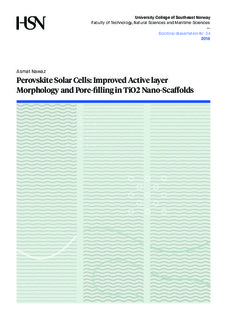Perovskite Solar Cells : Improved Active layer Morphology and Pore-filling in TiO2 Nano-Scaffolds
Doctoral thesis
Permanent lenke
http://hdl.handle.net/11250/2490718Utgivelsesdato
2018Metadata
Vis full innførselSamlinger
Sammendrag
Organometallic halide perovskite solar cells (PSCs) have recently shown tremendous research interest due to their remarkable photovoltaic (PV) performance reaching up to 22% power conversion efficiency in merely five years since their first solid-state high performing device reported in 2012. This high performance stems from judicious selection of charge transport layers and enabling efficient charge extraction at device interfaces, optimization of the perovskite composition such as inclusion of formamidinium (FA) or Caesium (Cs) or both into the commonly employed Methyl Ammonium cation (MA), and a control over perovskite layer morphology. The research work presented in this thesis primarily explores the influence of the perovskite MAPbI3 active layer morphology and crystallinity and the role of selective contacts such as widely employed TiO2 compact layers and one-dimensional scaffolds on the device performance and stability.
At first, the effect of perovskite morphology was investigated by employing solvent additives and anti-solvent treatment methods on the perovskite films developed via single-step and double-step methods. The solubility of the precursor solution was enhanced by adding a controlled amount of additive (in this case DI-H2O), resulting in a smooth and uniform MAPbI3 film surface. Similarly, a significant improvement in MAPbI3 morphology was observed upon anti-solvent treatment. The modified films not only showed higher crystallinity, but also a change in the perovskite energy levels. This shift in the energy levels favoured interfacial charge transfer leading to an improvement in open circuit voltage (1.08 V) up from 0.61V for an untreated rival. The effect of anti-solvent treatment on the MAPbI3 films deposited via double-step deposition method was also investigated. Unlike a significant improvement observed for the perovskite films developed via single-step method, we observed no significant difference on the perovskite morphology. We noted that the anti-solvent treatment only works well for initially bad perovskite films with poor surface coverage, and in the case of an already smooth film, it rather decreased the film thickness leading to a drop in light absorption and photocurrent.
We then investigated the role of one-dimensional (1D) TiO2 electron transport layers (ETLs), namely, TiO2 nanorods/and nanotubes on the device performance and stability. We particularly focused on improving the commonly observed inferior pore-filling of the perovskite in nanorods/nanotubes scaffolds which is a bottleneck for device performance. We demonstrated a perovskite healing process (recrystallization of MAPbI3 films in the methylamine gas environment) to improve the pore-filling in these 1D nanostructures, which was confirmed via scanning electron microscope imaging. Besides the improved pore-filling fraction upon healing, we also found an improvement in the perovskite crystallinity and formation of large crystal grains. Photoluminescence and electrical characterizations demonstrated an improved charge transfer in the healed films compared to their pristine analogous. We also observed a significant improvement in the power conversion efficiency and stability under continuous light soaking in perovskite solar cells fabricated using the healed perovskite films.
Består av
Article 1 Morphology Study of Inverted Planar Heterojunction Perovskite Solar Cells in Sequential Deposition, Asmat Nawaz, Ali Koray Erdinc, Burak Gultekin, Ceylan Zafer, Muhammad Tayyib, Kaiying Wang, M. Nadeem Akram, International Journal of Electrical, Computer, Energetic, Electronic and Communication Engineering, Vol:10, No:7, 2016Article 2 Insights into optoelectronic properties of anti-solvent treated perovskite films, Asmat Nawaz, Ali Koray Erdinc, Burak Gultekin, Muhammad Tayyib, Ceylan Zafer, Kaiying Wang, M. Nadeem Akram , Ka Kan Wong, Sajad Hussain, Lukas Schmidt-Mende, Azhar Fakharuddin, J Mater Sci: Matser Electron, pp. 1-7, 2017.
Article 3 Improved pore-filling of TiO2 nanorods and nanotubes scaffolds for perovskite solar cells, Asmat Nawaz, Ka Kan Wong, Carola Ebenhoch, Eugen Zimmermann, Zhaoke Zheng, Muhammad Nadeem Akram, Julian Kalb, Kaiying Wang, Azhar Fakharuddin, Lukas Schmidt-Mende, submitted to, ACS Applied materials & Interfaces.

